#grayson10
Explore tagged Tumblr posts
Text
He Walks: Dick Grayson, the Survivor
This is a meta written for the ten year celebration of Grayson. For @grayson10yearslater.
From it’s prologue in Nightwing #30, Grayson by Tom King and Tim Seeley, boldly poses its readers with the question of how to describe one of DC’s oldest and most iconic characters when he is stripped of his familiar superhero identities. Who is Dick Grayson when he can’t hide behind Robin? Nightwing? Batman?

[King, Tom; Seeley, Tim; Tynion IV, James, writers. Janin, Mikel; Hetrick, Meghan; Garron, Javier; Lucas Jorge, illustrators. Setting Son. Nightwing. 30, e-book ed. DC Comics, 2014. Page 30]
Divided into twenty issues and three annuals, the story explores the theme of identity from all angles, pushing Dick away from his comforts to dissect the different layers of his character. A hero, the end of the last issue seems to say, is the true answer to this difficult question.
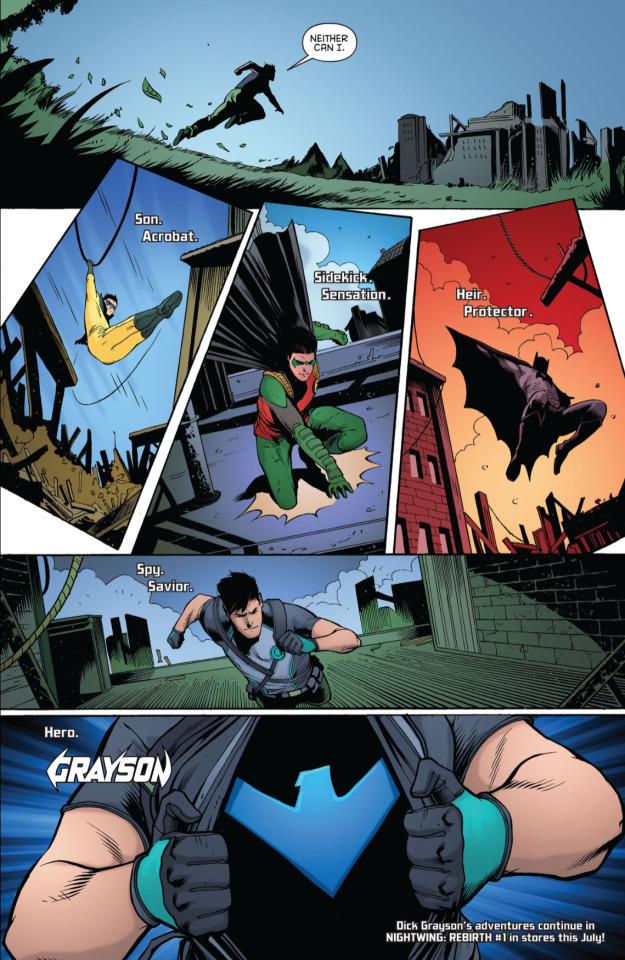
[King, Tom; Seeley, Tim, writers. Antonio, Roge, illustrator. Spiral’s End. Grayson. 20, e-book ed. DC Comics, 2016. Page 23]
And while that is undoubtedly true, each of the preceding nineteen issues elaborate on what traits can folded into a hero.
Dick is a storytelling, the first annual says;
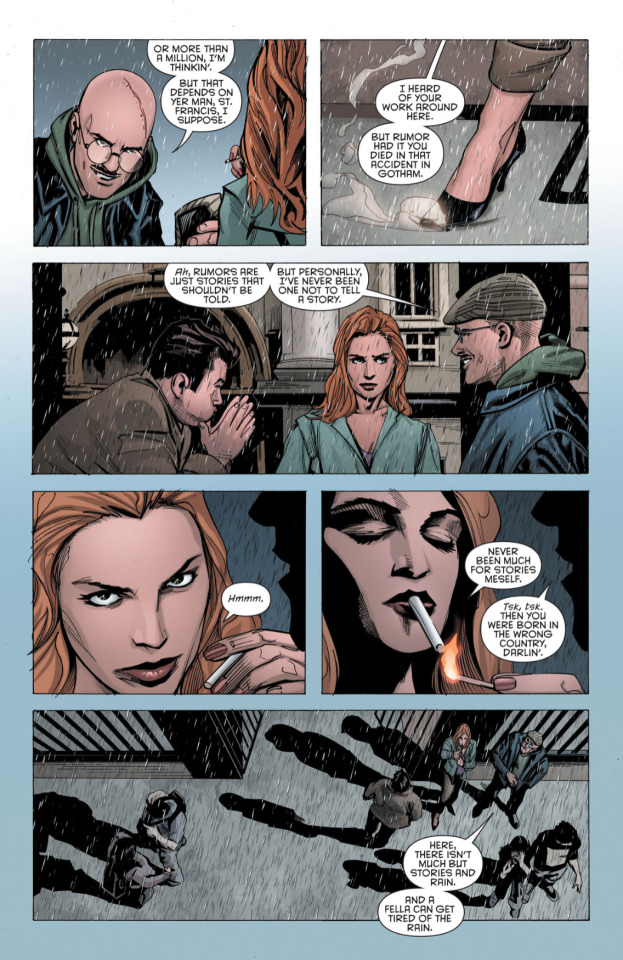
[King, Tom; Seeley, Tim, writers. Mooney, Stephen, illustrator. A Story of Giants Big and Small. Grayson. Annual 01, e-book ed. DC Comics, 2014. Page 11]
Dick is compassionate, the finale of Act I with the Paragon Brain proves;

[King, Tom; Seeley, Tim, writers. Mooney, Stephen, illustrator. Sin by Silence. Grayson. 07, e-book ed. DC Comics, 2014. Page 19]
Dick is a partner.


[King, Tom; Seeley, Tim, writers. Janin, Mikel, illustrator. Nemesis Part Two. Grayson. 10, e-book ed. DC Comics, 2014. Pages 23 to 24]
I want to focus a little bit on that last one. Dick, after all, was created to be the perfect partner. In 1940, he was the sensational character find that became Batman’s other half, the missing element to his mythos. Move further along his history, and a diverse number of writers were compelled to team Dick with other characters — he’s the Titans’ leader, the missing third piece of the World’s Finest, Batgirl’s love interest.
Grayson, too, is interested in exploring this aspect of Dick Grayson. In its first act, it pairs him up with Helena Bertinelli, whose more experience, tragic background, and darker personality is meant to mirror Batman.
Tom King: For me, it seems to make so much sense because basically she almost has that Batman female origin. She shares that origin that Batman and Dick have of having gone through this violent period when she was young and coming out of that a hero. We wanted to play with that. We wanted to play with the dichotomy of what Barbara is in Dick's life versus what Helena is in Dick's life. Helena's much closer to what Batman is and much closer to the father figure Dick was related to, so I think that creates immediate tension and fun stuff we can play with.
[Katzman, Gregg. "Interview: Tom King & Tim Seeley Talk GRAYSON." Yahoo! News, 4 Jan. 2015. Accessed 8 Dec. 2024.]
In act two, he is paired up with Tiger King of Kandahar. In fact, there is a theme of duality and partnerships throughout Grayson, showing that this is a critical aspect of who is Dick Grayson.
The exception to this is Grayson #05.
A self-contained story, Grayson #05 isolates Dick to get to the core of who he is. By contrasting Dick with Helena and Midnighter, placing him in the unforgiving vastness of an infernal desert, and calling forth the tale of Robin Dies at Dawn, Grayson #05 presents us with a man who does not give up and does not give in. Dick walks, even if he must walk, at times, alone. When laid bare, without the trappings of a superhero identity or of a partner, Dick Grayson, Grayson #05 says, is, at the core of his being, a survivor.
In this meta, I want to see just exactly how Grayson #05 does that through a close reading of the issue.
Now, without any further delay, let’s get started.
Let’s start with the cover.

[King, Tom; Seeley, Tim, writers. Janin, Mikel, illustrator. We All Die at Dawn. Grayson. 05, e-book ed. DC Comics, 2014]
Everything about this cover radiates heat. The sun is beaming down mercilessly, the spirals mimicking the sun rays, the color palette a strong orange that is highly saturated but not bright. The reader can feel how hot it is in this desert, and all around there's nothing but sand. Sand, sand everywhere the eyes can see, and in the center of the image, a lone black figure braving this infernal bare landscape.
This cover tells us not just the location of where the issue will be set, but it also shows that Dick will be alone out there. It tells us this will not be an action-filled story, but it will be one of survival. Man vs Nature, and nature does not discriminates with her ruthlessness. Dick stands alone facing the elements, but he stands. He is walking, he is not giving up. It would be so easy for this cover to have a close up of Dick's, Helena's, and Midnighter's exhausted expression as they each try to survive, but instead we just see Dick by himself, alone, walking. He does not give up, he does not give in. He survives.
The issue then opens in medias res, immediately presenting the readers with that main conflict: survival. It does not waste any time with unneeded exposition — after all, though Dick would hate this fact, we as readers do not need to know the name of the mother who is dying; we do not need to know the details of Minos’ mission before it all went wrong; we don’t even need to know how Midnighter managed to track Dick and Helena. All we need to know is that Dick and Helena, and Midnighter are all after the Paragon Heart, which belongs to the, as of this page, unborn baby; that ARGUS somehow tracked Midnighter who was fighting Dick for the Heart; and that mid-fight the mother went into labor.
There's an elegance in the way everything is conveyed so well and so quickly in this one page. It's brilliant storytelling from both a writing and a visual stand point.

[King, Tom; Seeley, Tim, writers. Janin, Mikel, illustrator. We All Die at Dawn. Grayson. 05, e-book ed. DC Comics, 2014. Page 01]
As they crash into the desert, the mother passes away. ARGUS is gone, but our trio and the newborn baby girl are faced with a mightier enemy: The desert. The nearest town is days away, they do not have a lot of supplies, they do not have how to call for help. Here, we’re faced with this issue’s main question: Can they survive this? The answer seems to be resounding “no.”
Let’s take a look at how each of the characters approach this situation.
Helena is pragmatic. She is thinking of the mission, but her expression is troubled. She doesn't see a way out of this. She knows they have to survive long enough for Spyral to eventually find them, but the odds are against them. Given the fact she’s injured, it’s unlikely she’ll ever make it out of this desert. Still, that does not mean she’ll fall into despair. She'll do what needs to be done, but she knows this is not something they can easily get out of. If she goes down, she'll go down fighting. Like I said, she’s pragmatic.
Midnighter, on the other hand, is a pessimist. He is jaded. Why bother trying? Midnighter is a nihilist. “We’re dead,” he says not once, but twice.
Then we have Dick. Beautiful Dick, he holds the baby in his arm like she's the most precious thing in the world. And in this moment, she is. His reply to Midnighter is telling. They aren’t dead. They can't be, because if they are dead, then so is she, so death is not an option. It's not a question of what is practical, of what the mission is, of what the odds are. It's not about being an optimist, either. It's simply about her. She is all that matters and she is entirely dependent on them, so they can't be dead. They cannot let her die, this little innocent child who is not even an hour old. So what will they do instead? They’ll walk. They’ll survive.

[King, Tom; Seeley, Tim, writers. Janin, Mikel, illustrator. We All Die at Dawn. Grayson. 05, e-book ed. DC Comics, 2014 Page 02-03]
The next page displays what will become the brilliant standard for this issue — open skies, sand, and small figures walking. Everything about it conveys this vastness that is so oppressive in its openness. It's the majesty of Mother Nature.
Note how tiny the figures are. Note how Dick leads the other two, not by a little, but by a lot. In his arms Dick holds the baby, nurses her with the formula from the mother’s bag. In the pages we see Helena struggling, Midnighter drinking water and shedding away his clothes, but Dick remains stoic. He leads, separated — isolated, distant — from the rest, determined, disappearing into the far orange of the page.
In this, we see Dick’s silent determination. It’s notable that he is not trying to make light of the situation through humor. Instead, he is silent. And he walks.
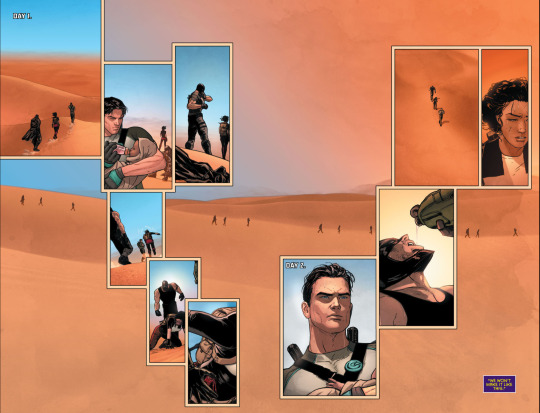
[King, Tom; Seeley, Tim, writers. Janin, Mikel, illustrator. We All Die at Dawn. Grayson. 05, e-book ed. DC Comics, 2014. Pages 04-05]
As the story continues, Midnighter’s pessimism deepens. It is notable that this issue is the first time Dick and Midnighter have seen each other since Grayson #01. And what does Midnighter do? He lashes out at Dick by revealing he knows who Dick is. This calls back to Forever Evil, where Dick’s identity was revealed to the world. Midnighter is weaponizing Dick’s trauma against him, trying to draw a reaction out of Dick. Not only that, he says that they only way to survive is to kill the baby and use the Paragon Heart. Otherwise, the odds are not in their favor, and he deems this "just walk" strategy is pointless. This is how Midnighter copes with the hopelessness of their situation — he dwells on the negative and lashes out.
Helena reacts to Midnighter by subduing the threat, but she doesn’t comment on his defeatist attitude. Nor on his plan. She is, again, practical. She won’t say they’ll make it, but she won’t allow Midnighter to pose a threat to the mission.
Dick, though… Not once does Dick acknowledge Midnighter’s taunting. Not once, not even to defend the baby. A weaker writer would have tried to get Dick to empathize with Midnighter, to tell him again that they're not dead yet, that they just need to keep trying. Instead, Dick’s refusal to even look at Midnighter shows how he won't even acknowledge the possibility of not surviving. His focus, instead, is all on her. That is what is driving him so that is what has his entire attention. Midnighter's temper tantrum is not even worth his time. Not when her survival is at stake.
I also want to take a moment to take in the environment. In this scene, the first panel shows how tiny the three of them are in the vast desert, the beautiful sky expanding above them. Mother Nature, the issue seems to say, is beautiful, worthy of awe. It is big, bigger than any human. More powerful, too. It is a challenge unlike any Dick has ever or will ever face. It cannot be charmed by him, it cannot be fought against, it cannot be conquered. It is not cruel or evil, either. It simply is, bare and uncomplicated, honest at all times. To survive her, Dick must also be the barest, least complicated version of his self.
While writing this, I often felt myself hesitating when writing about the conflict between Dick and desert. Phrases like “go against the desert,” often came to my tongue, and I had to swallow them back due to how wrong they felt. To “go against” someone (or something) is to have an antagonistic, adversarial relationship, and I’m not sure that is incredibly accurate to this scenario. The desert is indifferent towards Dick and the others. Midnighter speaks of fighting, of winning, of conquering this challenge, but Dick, by contrast, is quiet. He is not trying to “win” against the desert. That is not the right frame of mind. Rather, he is simply trying to survive.
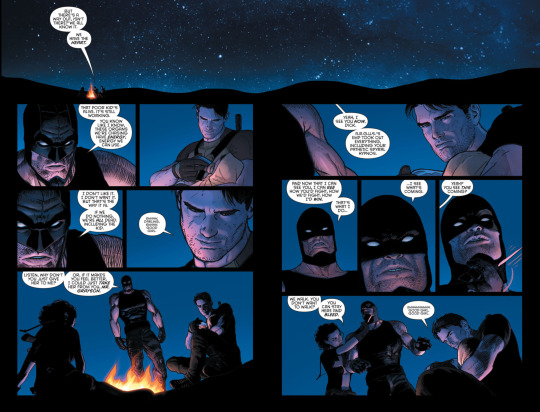
[King, Tom; Seeley, Tim, writers. Janin, Mikel, illustrator. We All Die at Dawn. Grayson. 05, e-book ed. DC Comics, 2014. Pages 06 - 07]
As time passes, Midnighter continues to talk. To taunt. His negative attitude doesn’t light up, and he is still trying to get a reaction out of Dick. Here we see that Midnighter is perhaps not fully comfortable with his enhancements, like he doesn't see himself as fully human because of them. He resents them even as he trusts his enhancements more than he trusts his own abilities. He says he sees all outcomes and there are none where they survive this. Not as humans. Not without the Heart.
Note how Midnighter presents their situation as not about being tough, but about how much energy you have. This framing seems to reject the idea of survival — of “toughing it out” — and instead looks at their situation as one of victory and defeat — you have to have enough energy to make it out of the desert, and in doing so, you’ll be victorious.
Yet, Midnighter predicts himself to outlast Dick, but in reality, he falls before Dick does. This begs the question: Was Midnighter right? Must you defeat the desert and win against it in order to win?
Personally, I believe the story is saying “no.” This is not about victory and defeat, but about survival. And to survive, one must lay themselves bare of foolish things such as pride and ego. To survive, you must dig deeper within yourself, and find something that will allow you to not go against mother nature, but to continue walking along side her.
Dick has found his something deep within himself. That something is his compassion. Helena collapses, and Dick leaves with her his shirt, laying himself bare. Yet, despite his fallen partner, his priority is still the baby girl. He will survive for her, and in this action we see the depths of Dick’s compassion for others. He continues to walk. He continues to survive.
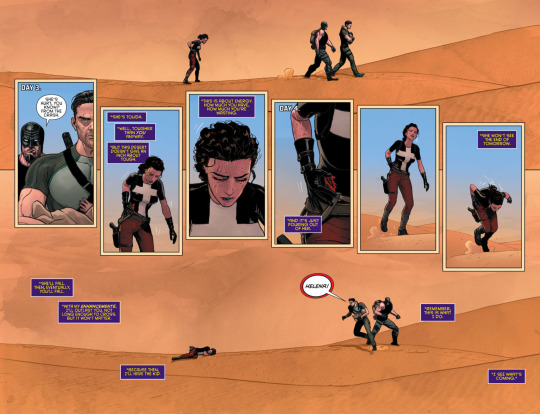

[King, Tom; Seeley, Tim, writers. Janin, Mikel, illustrator. We All Die at Dawn. Grayson. 05, e-book ed. DC Comics, 2014. Pages 08-10]
Finally, after days, Midnighter is confronted with the true force that is Dick Grayson. He was so certain he was going to outlast Dick. “I have… My… Enhancements. I have powers,” he struggles to say. But what does Dick have? How can a simple man continue to go against these conditions?
This page shows how deeply Midnighter underestimated Dick’s humanity and his compassion. Dick is not a superpowered individual, no, but Dick’s determination is unlike at other. This is who he is… Someone who walks.
Dick is a survivor. When Dick was a small boy, he lost his entire world in a traumatic act of violence. From the moment those ropes snapped and the Flying Graysons plunged to their deaths, Dick became a survivor — someone who had to figure out how to walk forward when everything seemed lost. And Dick did it.
If I can go on a bit of a tangent here, I’ll say that I really dislike whenever child heroes are characterized as child soldiers, be it by fans or by canon writers. This reading is, in my opinion, incredibly lazy and displays a lack of understanding of what superhero identities are meant to stand for. We can discuss the traumas that come along with being a child hero, but to dismiss it as a universally bad thing and equating to the real world horror of child soldiers ignores the fact that this is a fictional world in which the fantastical concepts act as metaphors for larger ideas.
Robin is not a child soldier. Robin, much like Batman, is a response to trauma. Specifically, Dick’s Robin is a response to the trauma of being a survivor of violent crime, and Robin demonstrates how a victim can regain agency and transform their tragedy into an empowering narrative. As Steve Braxi points out in his On Superman, Shootings, and the Reality of Superheroes essay, Batman “transform[s] trauma into will power,” and Dick, whose story is meant to mirror that of Bruce’s, does the exact same through Robin. Through Robin, Dick is able to not only find justice for his parents, but he is also to help other survivors like him. And that is what allows him to keep on walking.
This is what Grayson #05 demonstrates. It strips away the metaphor of the hero identities and the distraction of partnerships, laying Dick out bare and showing that as long as he can help someone, as long as he has his compassion, Dick Grayson can survive anything.
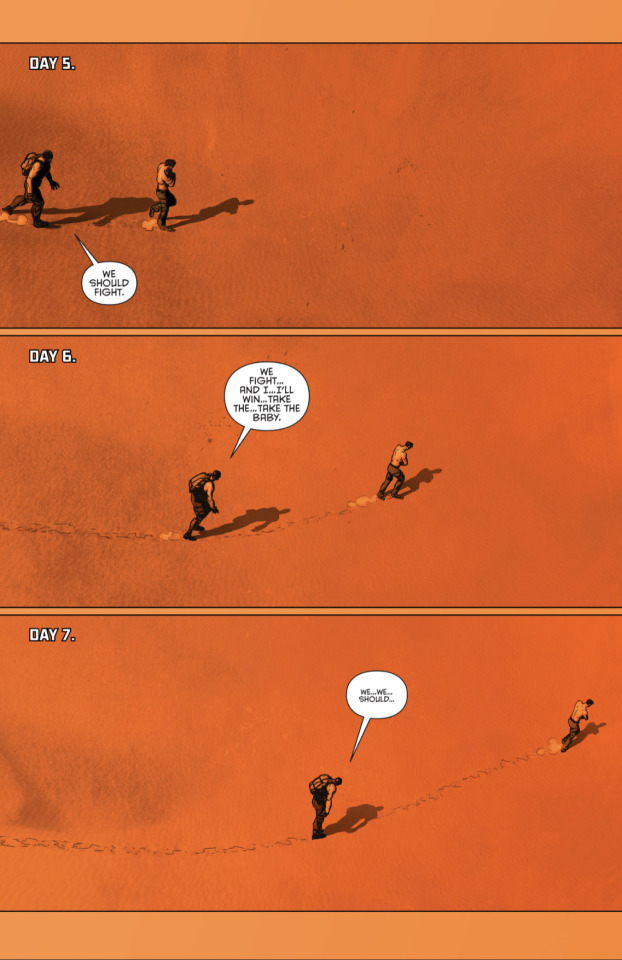

[King, Tom; Seeley, Tim, writers. Janin, Mikel, illustrator. We All Die at Dawn. Grayson. 05, e-book ed. DC Comics, 2014. Pages 12 - 13]
In the following page, the vastness of the desert is contrasted with close up shots of the baby. We see Dick, so impossibly small standing against a large desert that disappears into the horizon, and ocean of sand and oranges, and we see the whole reason why Dick is still alive. The environment that may kill him is contrasted with the reason why he will survive.
“I’m here. I’m here,” Dick tells the baby girl as she ceases her cries. “I’m still here.”
He gets up… And he walks. The repetitiveness of the action throughout the issue emphasizes the slog of the immediate aftermath of a traumatic event, those moments when you realize time is progressing forward as it always had, but your mind and heart are still stuck in that one moment that changed your life forever. All Dick can do is walk, walk, walk, yet he is still lost in this vast desert, the trauma is still overwhelming him, there’s no end in sight… But he does have his reason for not giving up — his compassion allows him to continue onward.

[King, Tom; Seeley, Tim, writers. Janin, Mikel, illustrator. We All Die at Dawn. Grayson. 05, e-book ed. DC Comics, 2014. Pages 14 - 15]
Robin Dies at Dawn is the title of Batman #156. In this two part story Batman finds himself in an alien planet filled with threats. Robin saves him from sentient, walking plants, and after escaping, they find a giant stone idol that comes to life and begins chasing them. They manage to leap over a deep fissure and realize that if the stone idol were to do the same, the unstable down would crumble and the stone idol would fall, securing their safety. As they wait for the idol, they see that it, too, realized the ground was unstable and it tries to figure out a safer passage to the other side. That’s when Robin provokes the stone idol, who, in fury, grabs a boulder to throw at Robin. Before it can do it, the floor crumbles and it falls, but boulder still hits Robin and kills him. Later, it is revealed that this was a hallucination induced by an experiment Batman subjected himself to meant to study the effects of loneliness in astronauts. Through the following days, Bruce has occasional hallucinations of alien creatures putting Dick in danger. It isn’t until Dick’s life is threatened by the Gorilla Gang that Bruce is able to “overcome” the lingering effects of the experiment, the threat to Dick’s life being enough to “shock” him back to normal.

[Finger, Bill; Boltinoff, Henry; Schiff, Jack, writers. Moldoff, Sheldon; Boltinoff, Henry, illustrators. Robin Dies at Dawn. Batman. 156, e-book ed. DC Comics, 1963. Page]
To the baby girl, Dick recounts this Golden Age story as if it were a dream, focusing on the part where the stone idol kills him with the boulder. In this tale, we go back to Robin, Dick’s first survival mechanism, and to the first person who first showed him compassion and to whom his survival was paramount — Batman.
Though so far Dick has rejected the idea of victory vs defeat, he presents the baby with a scenario where he is faced with such a conflict. Yet, in this case, to “go up against” the enemy is to call them forward so they will fall. Dick’s taunting leads the stone idol to it’s defeat, and this is the point which Dick says he wants the baby girl to focus on. You must welcome danger, he seems to say, and face it head on. You must walk forward instead of running away.
Yet, it is notable that the enemy is not the only one who is defeated in this story. After all, Dick “dies” at dawn. This is what Dick doesn’t want the baby to focus on, but I think it’s important in understanding this idea of survival. In the story, Dick sacrifices himself so Batman can escape. He goes up against an enemy, he achieves victory, but he does not survive. But, crucially important, Batman does.
This paints a picture where Dick's survival and his victory are not one and the same. Not the way Midnighter seemed to have believed. While Dick’s compassion is intrinsically tied to his status as a survivor of violence, this story seems to indicate that Dick will readily relinquish his own survival for the sake of someone else. In the framing of victories and defeats, other people’s safety -- other people's survival -- is Dick’s “win” condition.
This, I believe, demonstrates how Dick's compassion allows him to pass own his survivor status to others, even at the cost of his own life. By shielding them and giving them the opportunity to move past a trauma, Dick creates other survivors. He becomes their protector, their patron saint.

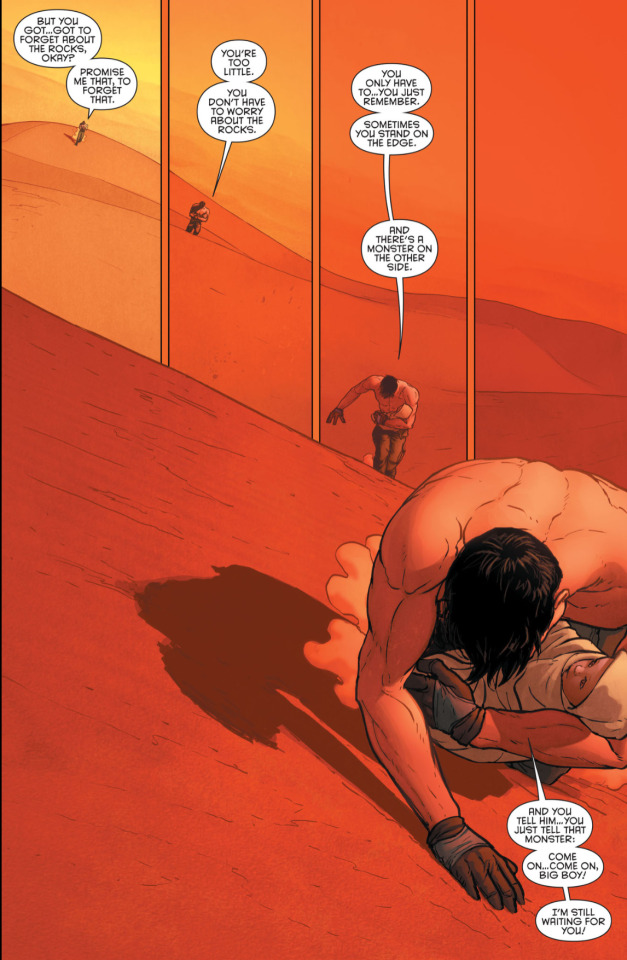
[King, Tom; Seeley, Tim, writers. Janin, Mikel, illustrator. We All Die at Dawn. Grayson. 05, e-book ed. DC Comics, 2014. Pages 16 - 18]
Dick Grayson is a lot of things, and he has numerous qualities. He is a partner, a hero, and a friend; he’s good, he’s funny, and he’s brave. While all of those are important aspects of his character, they can also distract from one characteristic that is crucial to Dick’s genesis.
Before he was Agent 37, before he was Nightwing, before he was Robin, Dick was a survivor. Having survived violence, Dick used his compassion to transform his trauma into power. Grayson #05 isolates Dick from the world, putting him in a dangerous and revealing desert to expose his ability to survive through his compassion. This, the story says, is who Dick at the core of his being, when stripped away from the distractions of partnerships and superhero metaphors. This is who Dick Grayson is: He is a man who walks.
Bibliography:
Braxi, Steve, “On Superman, Shootings, and the Reality of Superheroes” Comics Bookcase, September 2021
Finger, Bill; Boltinoff, Henry; Schiff, Jack, writers. Moldoff, Sheldon; Boltinoff, Henry, illustrators. Robin Dies at Dawn. Batman. 156, e-book ed. DC Comics, 1963
Katzman, Gregg. "Interview: Tom King & Tim Seeley Talk GRAYSON." Yahoo! News, 4 Jan. 2015. Accessed 8 Dec. 2024
King, Tom; Seeley, Tim, writers. Janin, Mikel, illustrator. We All Die at Dawn. Grayson. 05, e-book ed. DC Comics, 2014
King, Tom; Seeley, Tim, writers. Mooney, Stephen, illustrator. A Story of Giants Big and Small. Grayson. Annual 01, e-book ed. DC Comics, 2014
King, Tom; Seeley, Tim, writers. Mooney, Stephen, illustrator. Sin by Silence. Grayson. 07, e-book ed. DC Comics, 2014
King, Tom; Seeley, Tim, writers. Janin, Mikel, illustrator. Nemesis Part Two. Grayson. 10, e-book ed. DC Comics, 2014
King, Tom; Seeley, Tim, writers. Antonio, Roge, illustrator. Spiral’s End. Grayson. 20, e-book ed. DC Comics, 2016
King, Tom; Seeley, Tim; Tynion IV, James, writers. Janin, Mikel; Hetrick, Meghan; Garron, Javier; Lucas Jorge, illustrators. Setting Son. Nightwing. 30, e-book ed. DC Comics, 2014
73 notes
·
View notes
Text

Happy to report that I'm participating in @grayson10yearslater! DickTiger nation we are so back, because the way I am going to exhaust that tag during this year-long event...
With the event starting on July 9th 2024, I'll just be sitting here vibrating for a month, waiting. Stay tuned.
#grayson comics#grayson comic#grayson#agent 37#nightwing#dick grayson#dc comics#richard grayson#grayson10#dc tiger#helena bertinelli#tiger king of kandahar#midnighter#lucas trent
18 notes
·
View notes